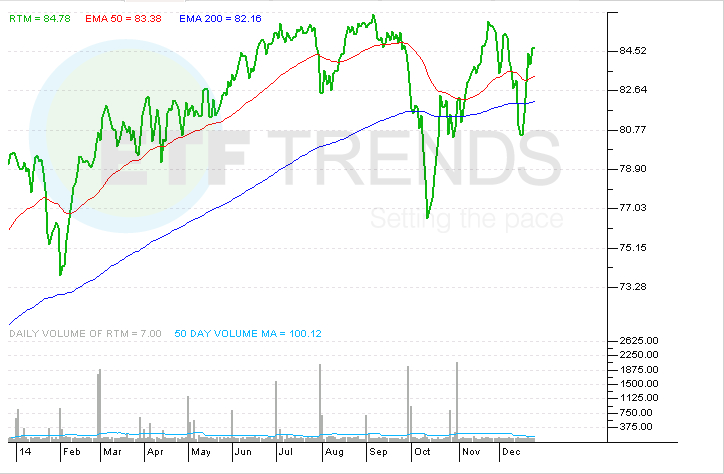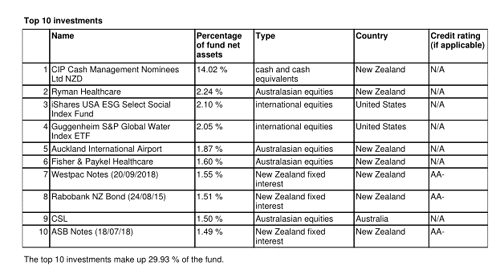Fund Spotlight Series – Guggenheim’s Equal Weight Index Funds Begin To Invest
Post on: 21 Июль, 2015 No Comment

by Begin To Invest on January 3, 2014
Investors in a simple S&P 500 index fund did tremendously well in 2013, beating a majority of actively managed investment strategies. But there is one strategy that has consistently outperformed a general market weighted S&P 500 index fund over the past few years and has been getting significant press the last few months. What is this strategy and is this strategy for you?
The strategy involves equally weighting your investments in an index compared to weighting based on a company’s market capitalization.
Equal weight funds split the fund’s assets evenly among the components of the index. In the case of the S&P 500, that means about 0.20% in each stock making up the index.
How does that differ from the regular market cap weighted index funds available today?
A typical S&P 500 index fund has holdings today weighted like this:
Heavily weighted on the very largest of companies.
While minimally invested in smaller companies:
(The 0.03 and 0.02 represent 0.03% and 0.02% weight)
So a $10,000 investment in an S&P 500 index fund results in about $304 invested in Apple stock, $266 in Exxon Mobil, while a company like First Solar gets about $2.
The typical index fund has performed very well for many investors (and will continue to do so over the long term). Index funds offers investors diversity for a very low cost and consistently beat the majority of Wall Street professionals.
But index funds do expose investors to a particular additional risk. They are constantly most heavily weighted in the biggest companies, which are potentially the stocks that are the most overvalued. As a stock’s price rises (and therefore its market cap rises as well), a market cap weighted fund will sell stocks which have gone down to buy more shares of the company’s stock that has risen.
Value investors like Ben Graham and Warren Buffett would say that investors should be doing the opposite.
In late 2012, Apple’s stock price was around $700. It became the largest company by market cap in history and at one point made up nearly 6% of the S&P 500. At this time an investor in an S&P 500 index fund would have 6% of their investment allocated to Apple alone, which is quite a lot for a fund made to spread an investment out over 500 different companies.
But there was a problem. As Apple approached $700 and was being hyped by nearly every “financial expert” on TV, it was becoming significantly overvalued.
Recall Warren Buffett’s famous quote: “Be fearful when others are greedy and greedy when others are fearful”
As greed approached bubble territory, experts predicted Apple would soon be worth $1 Trillion. As Apple soared higher, investors in index funds had their investments allocated even heavier to Apple buying one of the most overvalued stock in the index while selling the undervalued ones.
So when Apple turned lower over the first half of 2013, investors in S&P 500 index funds saw their largest holding drop nearly 50%.
Equal Weight ETFs Help Ease the Pain
At this same time, Guggenhiem’s Equal Weight S&P 500 ETF was constantly taking profits as Apple’s stock priced increased and allocating those profits to securities which had fallen in price.
The equal weight ETF had holdings that looked much different than a traditional index fund. Shown below is the holdings for an S&P 500 Equal Weight Index Fund. It will have all the same holdings as a typical S&P 500 index fund shown above, but the holdings are weighted much differently.
Every component is weighted equally, right around 0.2% of the fund’s assets. In other words, on a $10,000 investment, each company would be responsible for about $20.
This allowed Equal Weight ETF investors to feel very little pain compared to traditional index fund investors as Apple continued to drop.
As you can see in the chart above, as Apple declined sharply, RSP began to outperform the S&P 500 index.
In fact, the equal weight strategy has worked well over long periods of time.
Does this strategy always work? What are some potential pros and cons for an equal weight ETF? For a better look at the strategy, lets first look at a few Equal Weight ETFs and see how they have performed compared to their market cap weighted indices.
Guggenheim offers 17 Equal Weight ETFs covering indices for large cap companies (The S&P 500 index), several for mid cap companies (The Russell Mid Cap Index and S&P Mid Cap 400 Index) and several more for small cap companies (The Russell 2000 index, S&P Small Cap 600 Index). Also offered are 2 equal weight international and emerging market ETFs and a whole set of equal weight S&P 500 sector ETFs.
All funds will be shown below, with special attention on just 3.
RSP – Guggenheim S&P 500 Equal Weight ETF
- Expense Ratio: 0.4%
- Dividend Yield: 1.3% based on last 12 months of dividends.
- Made up of 500 holdings – Each with about a 0.20% weight.
Compare this fund to a typical market cap weighted S&P 500 index fund such as State Street’s fund, ticker symbol SPY.
Investors in RSP sacrifice some dividend yield, 1.3% compared to 2% for a typical S&P 500 index fund, due to heavier weightings in smaller companies that pay little to no dividends.
Investors also pay a heavy premium for the Equal Weight ETF with an expense ratio of 0.4% compared to the 0.05% 0.1% typically charged by an S&P 500 index fund. For a $10,000 investment which grows at 5% per year over the next 30 years that means about $3,000 potentially lost due to fees!
RSP is the only Equal Weight fund offered which typically has decent volume of shares traded. The other funds listed below typically have only several thousand shares traded each day, which may pose potential problems for invested such as higher bid/ask spreads or not being able to sell shares at the market price immediately if needed.
We saw above that equally weighting your investments in the S&P 500 index has paid off over time, does the same strategy work in other indices as well?
EWRM – Russell MidCap Equal Weight ETF

- Expense Ratio: 0.42%
- Dividend Yield: 1.23%
- Made up of 820 holdings.
EWRM has not been around as long as RSP, so we can only look at a few years of performance comparisons. Used in the chart below is iShares Russell MidCap index ETF with ticker symbol IWR, which has an expense ratio of 0.2%, half of EWRM’s and about 220,000 average daily volume compared to 10,000 for EWRM.
Part of the reason for the similar performance may be that the weightings of EWRM’s holdings vary much more than RSP’s. Weightings currently vary from 0.35% to 0.05% for each of the 820 holdings. These should get closer to even each time the fund rebalances. After looking at the fund below, we can start to see a pattern emerging with the performance of equally weighted ETFs and their holdings.
EWRS – Guggenheim Russell 2000 Equal Weight ETF
- Expense Ratio: 0.43%
- Dividend Yield: 1.33%
- Made up of 1972 holdings.
EWRS is the equal weight version on a typical Russell 2000 index fund, like iShare’s ETF with ticker symbol IWM.
Their returns since early 2011 are very similar, with IWM outperforming by a few percentage points.
So, equal weighting is not a sure fire way to beat an index based on market cap weightings.
Why is there a significant difference between the recent performance of RSP and these smaller cap equal weight ETFs compared to their market cap weighted indices?
One major difference can be seen by the holdings of EWRS compared to IWM.
Because IWM’s assets are spread out over roughly 2000 holdings, IWM’s top holdings make up only about 0.3% of the fund’s assets. EWRS’s top holdings make up only a little less at 0.22%.
Recall our example earlier when Apple was making up nearly 6% of the S&P 500 index at one time. RSP only weighted Apple at 0.2% of the fund’s assets, which is quite a difference. This difference creates the opportunity for differences of performance between RSP and SPY if higher weighted stocks underperform.
But when indices and equal weighted funds have their assets spread out to thousands of companies and have similar weights on the holdings, the opportunity to outperform or underperform diminishes.
Effectively, at its current weightings, paying the extra 0.2% in expense ratios for EWRS doesn’t get you much over IWM.
Other Equal Weight Guggenheim ETFs
Guggenheim offers a number of other equal weight ETFs. Currently, the daily volume on these funds is next to nothing so investors should consider these carefully. Besides those funds mentioned above, Guggenheim offers:
- EWMD – S&P 400 Mid Cap Equal Weight ETF
- EWSM – S&P 600 Small Cap Equal Weight ETF
- EWRI – Russell 1000 Equal Weight ETF
- EWEF – MSCI EAFE Equal Weight ETF (Europe, Australia, Far East developed markets)
- EWEM – MSCI Emerging Markets Equal Weight ETF
www.begintoinvest.com/fund-spotlight-series-vanguard-vs-spdrs-sector-etfs/
- RCD – Consumer Discretionary S&P 500 Sector Equal Weight ETF
- RHS – Consumer Staples S&P 500 Sector Equal Weight ETF
- RYE – Energy S&P 500 Sector Equal Weight ETF
- RYF – Financials S&P 500 Sector Equal Weight ETF
- RYH – Healthcare S&P 500 Sector Equal Weight ETF
- RGI – Industrials S&P 500 Sector Equal Weight ETF
- RTM – Materials S&P 500 Sector Equal Weight ETF
- RYT – Technology S&P 500 Sector Equal Weight ETF
- RYU – Utilities S&P 500 Sector Equal Weight ETF
Conclusion
In market cap weighted indices where top holdings take up a large proportion of a fund’s assets, an equal weighting strategy can potentially produce results much different than its market cap weighted index.
In several equal weight ETFs, long term market uptrends have led to equal weight ETFs outperforming their market cap weighted counterparts, but it should be noted that this outperformance comes after underperformance in market declines.
Equal weighting tends to tilt your investments toward a value investing approach, where the fund is selling “winners” and buying “losers”, which has historically been a good bet. But there is no guarantee that that bet will continue to pay off.
The value of these funds is apparent in certain situations like the market experienced in 2011 with a large company like Apple dominating its index. These funds are not a replacement to your standard index funds, but may help to lessen your allocation to stocks in times of market euphoria of a few select securities.














